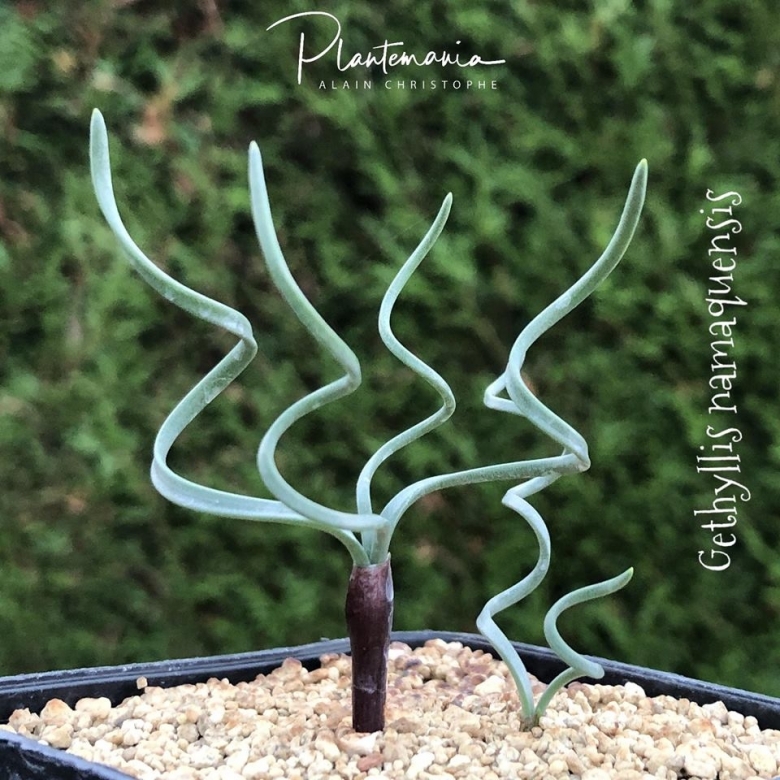
Gethyllis namaquensis Photo by: © Plantemania
Three years old.
Origin and Habitat: Gethyllis namaquensisSN|35517]]SN|35517]] is widespread across the Richtersveld (northern Cape, South Africa) and extends into southern Namibia.
Habitat and ecology. Desert, Succulent Karoo shrubland. This elusive species is found in coastal sand and on gravelly mountain slopes. G. namaquensis exhibits a special morphological adaptations of its aerial parts to harvest and absorb water from dew and fog, the main source of moisture in this region. It pass its vegetative phase in winter. Leaves display a spiral, helical, tortuose, or serpentine shape that, promote an increased deposit of dew and fog by enlargement of surfaces, keeping at the same time the overall size of the leaves restricted. It flowers from November to December. Fruits are harvested for food and medicine, and plants are sometimes collected for horticultural purposes, but in spite of this, this species is still very common. Overgrazing, the most severe threat to plant species in the Richtersveld, does not appear to impact the population. This species occurs as scattered individuals. It persists even in severely overgrazed areas, and the population is stable.
Synonyms:
See all synonyms of Gethyllis namaquensis
back
Accepted name in llifle Database:Gethyllis namaquensis (Schönland) Oberm.Bothalia 13: 136 1980.Synonymy: 3
back
Common Names include:
AFRIKAANS (Afrikaans): kukumakranka
Description: Gethyllis namaquensisSN|35517]]SN|35517]] is a deciduous perennial herb up to 30 cm high, with a bulb and flat gray green smooth erect leaves that are spirally arranged, densely tufted and enclosed by a prominent, swollen, basal cataphyll or sheath. The brown disc-shaped swelling of the upper part of the cataphyll distinguished it from other species. The flowers are large, white or lilac. Schonland placed the species in a new monotypic genus Klingia, which he named in honour of the collector. He separated the genus from Gethyllis on the grounds of the six filaments which are fused at the base and expanded into a wide cup or corona.
Leaves. Erect, laxly spiralled, flat, gray green, smooth, densely tufted and enclosed by a prominent, inflated, basal sheath. The leaves appear in winter after the plant has flowered and set seed. It can be
Flowers. Large, cupshaped, white or lilac. Filaments of the 6 stamens joined at the base.
Fruits: Large, fleshy, pale yellow. The fruits appear in summer after the flowers have died, but usually before the leaves emerge.
Bibliography: Major references and further lectures
1) A. A. Obermeyer, “NOTES ON AFRICAN PLANTS, A NEW COMBINATION IN GETHYLLIS, Gethyllis namaquensis ( Schonl .) Oberm., comb. nov.”, Bothalia Volume 13, 2016 https://archive.org/details/bothaliavolume1313unse
2) Annelise le Roux, “Wild Flowers of Namaqualand: A Botanical Society guide”, Penguin Random House South Africa, 8 mag 2015
3) Hall, A.V., De Winter, M., De Winter, B. and Van Oosterhout, S.A.M. 1980. “Threatened plants of southern Africa”. South African National Scienctific Programmes Report 45. CSIR, Pretoria.
4) Hilton-Taylor, C. 1996. “Red data list of southern African plants”. Strelitzia 4. South African National Botanical Institute, Pretoria.
5) Müller-Doblies, D. 1986. “De Liliifloris notulae 3. Enumeratio specierum generum Gethyllis et Apodolirion (Amaryllidaceae)”. Willdenowia 15(2):465-471.
6) Raimondo, D., von Staden, L., Foden, W., Victor, J.E., Helme, N.A., Turner, R.C., Kamundi, D.A. and Manyama, P.A. 2009. “Red List of South African Plants”. Strelitzia 25. South African National Biodiversity Institute, Pretoria.
7) Snijman, D.A. & Raimondo, D. 2015. Gethyllis namaquensis (Schönland) Oberm. National Assessment: Red List of South African Plants version 2017.1. Accessed on 2018/11/26
8) Pacific Bulb Society “Gethyllis” web http://pacificbulbsociety.org/pbswiki/index.php/gethyllis
9) Stefan Vogel, Ute Müller-Doblies, “Desert geophytes under dew and fog: The “curly-whirlies” of Namaqualand (South Africa)” Flora 206 (2011) 3–31









